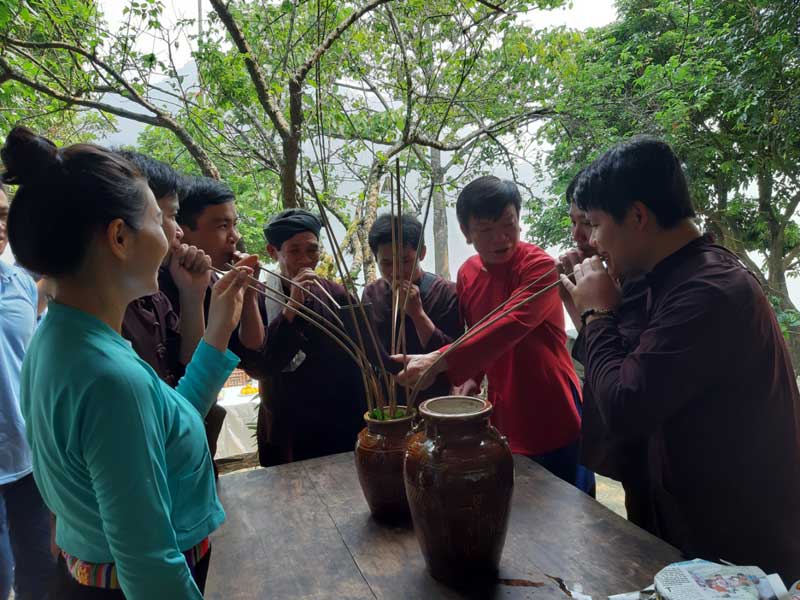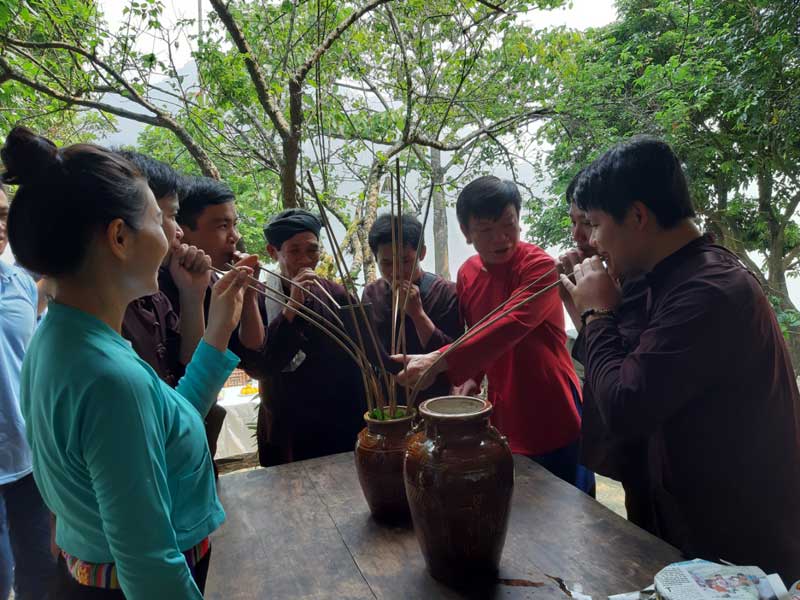
(HBO) - With a peaceful beauty, the ancient land of Muong Bi, Tan Lac district today is also a picture with the hillsides of red and green-skinned pomelos, concrete streets with colourful flower taking visitors to community tourist sites.
 Tourists experience Muong cuisine culture in Ngoi village, Ngoi Hoa commune, Tan Lac district.
Tourists experience Muong cuisine culture in Ngoi village, Ngoi Hoa commune, Tan Lac district.
As agriculture is a key economic sector with existing potential and advantages, the district has issued a number of resolutions on agricultural economy, thereby gradually creating an intensive farming area using technological advances to produce quality products.
Up to now, the district has converted 2,500 ha of ineffective rice cultivation area into crops with high economic efficiency, renovated over 670 ha of orchards. At the same time, it is developing crops that suit advantages of each region such as red-flesh grapefruit and green-skinned grapefruit with a total area of 1,100 ha, up 220 percent compared to the resolution’s target, while growing watermelon, squash, peanut and bean in a 440ha lowland area, sugarcane in a remote area of about 1,450ha, tangerine, chayote, and purple garlic on a highland area of around 195ha. The locality is now home to about 300ha of plants meeting VietGAP standards and three products registering collective trademarks. Each hectare brings an average revenue of over 200 million VND. Grapefruit cultivation alone rakes in 400-700 million VND per ha on average.
Together with enhancing agricultural production value, the district considers trade, services and tourism as a breakthrough in economic development. It is now home to more than 200 enterprises, cooperatives, production and trade facilities working in industry and handicraft. The total value of industry-handicrafts-construction products neared 4 trillion VND while production value grew by 22.6 percent, up 7.6 percent compared to the resolution.
Muong Bi ancient land is also endowed with fresh climate, beautiful and majestic scenery. Over the past years, the district has adopted a number of measures to uphold the potential and strengths to develop tourism. It directed the comprehensive planning of cultural and spiritual site But - Muong Chieng cave in Man Duc town, upgrade of Nam Son cave in Van Son commune, building of Muong village in Luy Ai hamlet, Phong Phu commune, and development of community-based tourism at Ngoi village in Suoi Hoa commune, Chien village in Van Son commune and Buoi Cai village in Phu Cuong commune.
Looking back on local socio-economic development over the past years, Chairman of the district People’s Committee Bui Van Nho said local socio-economic development has seen positive changes with improving material and spiritual lives. The new-style rural development is also progressing with each commune meeting 14 criteria on average. Local economic targets met or surpassed the resolution’s. The agro-forestry-fisheries sector accounted for 31.3 percent, industry-handicraft-construction 31.5 percent, trade-service-tourism 37.2 percent. In particular, revenue to the local State budget rises by 24.9 percent each year.
In the near future, the district will continue improving leadership and fighting capacity of its Party Organisation, building a strong and comprehensive political system, upholding the power of great national unity, pooling every resource to step up breakthroughs for socio-economic development. It will strive to reduce the rate of poor households to 4 percent per year and raise the average income per capita to 50 million VND by 2025./.
The Standing Board of the Hoa Binh provincial Party Committee has agreed in principle on a proposal by the Standing Board of the Party Committee of Hoa Binh city to gather feedback on the city’s 1:2000 zoning plan, which forms part of its broader urban development strategy.
Hoa Binh province has made notable progress in public administration reform and digital government development, with the satisfaction index among citizens and businesses reaching over 84%, according to recent government evaluations.
Thanks to great efforts by local authorities in recent times, the governance and public administration performance of Mai Chau district has been significantly improved.
In the afternoon of June 6, the Party Committee, the People's Council, the People's Committee and the Fatherland Front of Lac Son district solemnly held a meeting to celebrate the 139th anniversary of the district's founding (1886–2025) and the 79th anniversary of the establishment of the district's Party Committee (1946–2025). There was the attendance of Mr. Bui Van Thang, the Vice Chairman of the Provincial People's Council; Mr. Quach Tat Liem, the Vice Chairman of the Provincial People's Committee; Ms. Dang Bich Ngoc, the Deputy Head of the National Assembly Delegation of the province; as well as the former leaders of the province and district through various periods, who are the natives of the district.
Implementing the Politburo’s Resolution No. 57-NQ/TW on breakthroughs in science – technology, innovation, and digital transformation is a golden opportunity for the northern mountainous province of Hoa Binh to renew growth model, improve competitive edge and shorten digital gap.
Resolution 57-NQ/TW, issued by the Politburo on December 22, 2024, identifies sci-tech, innovation, and digital transformation as strategic breakthroughs to build a developed and prosperous nation. In Hoa Binh province, this spirit is not just a slogan, it’s being put into action through concrete initiatives that form a "new development triangle”: digital citizenship, digital economy, and digital administration.



 Tourists experience Muong cuisine culture in Ngoi village, Ngoi Hoa commune, Tan Lac district.
Tourists experience Muong cuisine culture in Ngoi village, Ngoi Hoa commune, Tan Lac district.